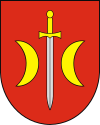51°46' N 20°33' E, 38.5 miles SSW of Warszawa. Konstantynów Łódzki is a town in Pabianice County, Łódź Voivodeship with 17,569 inhabitants in 2004. Incorporated in 1924, but originally founded in the 1820s by a landowner who had planned to build a textile industry, in 1821 Konstantynów Łódzki village officially became a part of the textile industry of the Łódz region. In 1824, the town has been given its current name and has been established as a town in 1830. Jews settled in Konstantynów even before it became a factory town. Weavers and other textile experts from within and outside Poland arrived. The legal status of the Jewsby a government decree in 1830 was "to prevent the damaging concentration of Jews in Konstantynów, it is established that the municipal office will accept as residents of the city only those who present residency permits signed by the mayor." In 1862, an order of the Czar canceled all restrictions on the mobility of Jews in the Kingdom of Poland. Even after 1862, the increase in Jewish population was slow because the weaver's guild did not permit Jews to work in the textile industry. Jews did not want to work in the factories because of Shabbat. Regular migration of Jews into nearby Łódź also limited interest in residence here. The vast majority of Jews were salesmen or other traditional Jewish tradesmen. Still, in 1825 an independent Jewish community existed with a synagogue, a house of study, mikvahs, a poorhouse, and a cemetery which remains consecrated to this day, and employed a dayan [dayan]. The government was reluctant to recognize the independence of the community because they rented buildings. The mayor supported an independent community authorized in 1835 with a rabbi. Until the end of WWI, Radoszyce-Sobota hasidim and hasidim of Gur, Alexander, Sochaczew, each had their own shtiebl. Rabbi Yaakov Aron Levi, Konstantynów had a yeshivah with 80 students from both the town and its environs. In 1921, 97 Jewish factories or workshops employed 186 workers. 51.6% of them were the owners of the businesses, 48.4% were wage earners. 39dealt with textiles and employed 93 workers, mostly Jewish. These businesses operated as domestic industries and sold their products to three to five local Jewish factory operators or to the factories in Łódź. The German occupation of the city on September 7, 1939 found many Jews escaping the city, primarily to Łódź. The Volksdeutsch asserted that these Jews would be executed when they were caught. Polish doctors were shot. Jews were taken for slave labor. Persecution and robbery were rampant. After four months of occupation, on December 22, 1939, the local government ordered the Jewish population expelled. Gathered at the Town Hall, the head of the German police organized the expulsion. Elderly and weak Jews were permitted to ride on wagons rented by the Judenrat. Under armed guard, the Jews left for Głowno. On the way some of the Jews escaped by bribing the guards and fled to Łódź. The rest went to Głowno and from there many escaped , particularly Łódź and Warsaw.
People who would like to donate to restoring the Jewish cemetery should go to the website that was created to find people willing to share the cost of restoring this cemetery. From the website: "We have take[n] the initial steps in determining what would be needed to initiate a limited restoration of this cemetery which was destroyed by the Nazis. At the present time this cemetery has no fence and no gravestones. (The Nazis removed them and made a walk - with the writing facing up - leading to the building they designated as Gestapo headquarters.) There is no sign or monument to mark the area as a Jewish cemetery. As a minimum, we would like to erect a fence and monument. We would also like to initiate an effort to find the gravestones which were most probably taken by the local residents after the war ended." Source: Henry Zandberg. See website for photographs and more information. [April 2011]
US Commission No. POCE000055
Konstantynow is located in Lodz at 51°45 19°20, 10 km from Lodz. The cemetery location is Taska Street. Present population is 5.000-25.000 with fewer than 10 Jews.
- Local: Urzad Miasta, Ul.Zgierska 2, tel. 111903.
- Regional: Wojewodzki Konserwator Zabytkow, 90-926 Lodz, ul. Piotrkowska 104.
Earliest known Jewish community was about 1821. 1921 Jewish population was 942. The cemetery was established in the first half of the 19th century with last Orthodox burial 1935-45. Landmarked: in the official register of Jewish cemeteries 1981. The isolated suburban hillside has no sign or marker. Reached by turning directly off a public road, access is open to all. A broken fence and no gate surround. The size is.9 ha. No gravestones are visible, no mass graves and no structures. Municipality owns site used for recreation. Adjacent properties are recreational. Private individuals rarely visit. The cemetery was vandalized during WWII. There has been no maintenance, no care. No threats.
Pawel Fijalkowski, Ul.Ziemowita 11, 96-500 Sochaczew, tel. 227-91 completed survey on 09/12/91. He visited the site in 06/90. There were no interviews.

